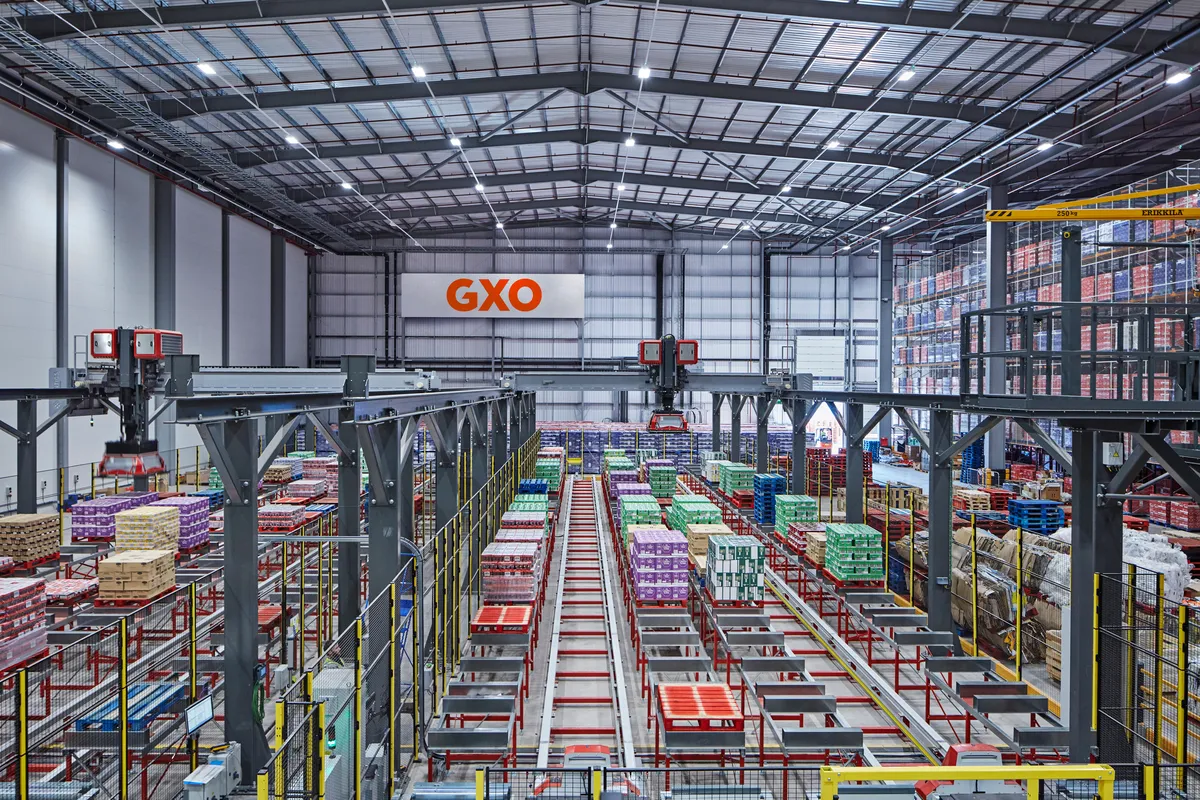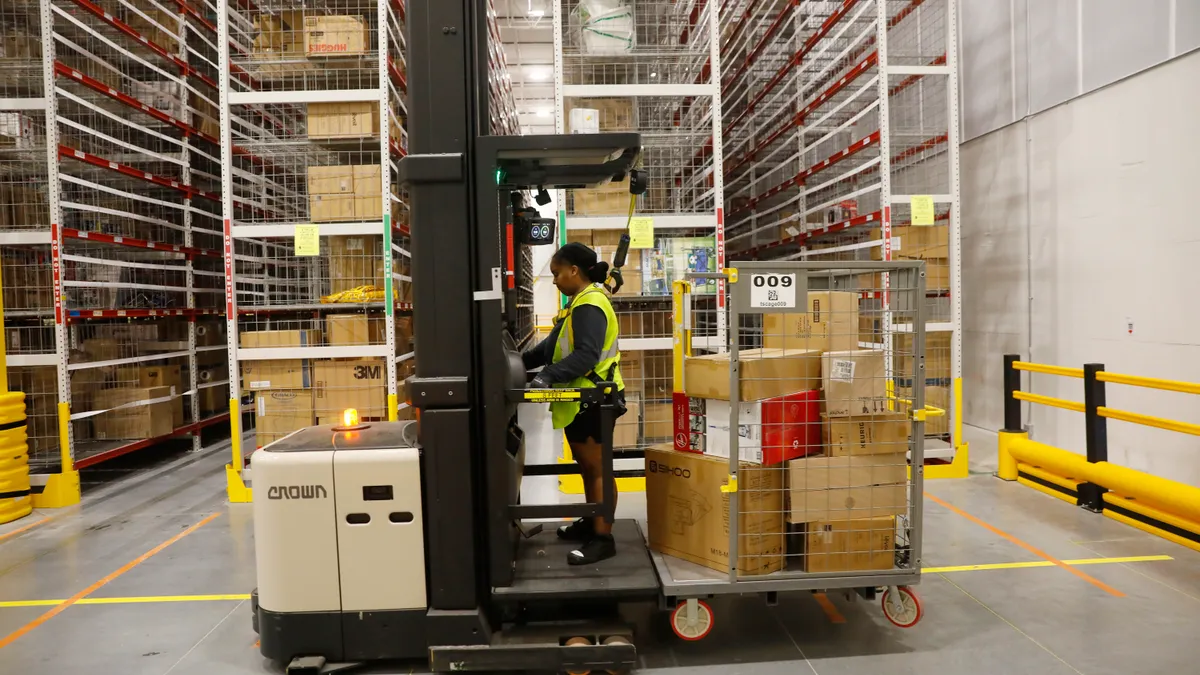The U.S. warehouse hiring boom continues to fade as companies shift their focus from expansion to efficiency within their supply chain networks.
In December, the number of warehousing and storage employees fell to 1.85 million workers, according to preliminary data from the Bureau of Labor Statistics. That's the lowest employment count in the sector since November of 2021.
Employment numbers dwindle in warehouse sector
More layoffs are coming in the sector in 2024. Several retail brands, e-commerce players and third-party logistics providers have already disclosed facility closures and job cuts starting this year, impacting over 2,800 employees tied to warehouse and distribution operations.
Facility closures and layoffs in 2024
| Employer | Facility location | Employees impacted | Date layoffs begin |
|---|---|---|---|
| Saks | Wilkes-Barre, Pennsylvania | 90 | Jan. 6 |
| GXO | Groveport, Ohio | 192 | Jan. 15 |
| Zulily | Lockbourne, Ohio | 274 | Feb. 7 |
| Radial | Louisville, Kentucky | 137 | Feb. 29 |
| DHL eCommerce | Elkridge, Maryland | 120 | March 1 |
| Ahold eCommerce Sales Company | Jersey City, New Jersey | 454 | March 1 |
| GXO | Memphis, Tennessee | 211 | March 6 |
| Newell Brands | Pataskala, Ohio | 190 | March 8 |
| Schenker, Inc. | Carlisle, Pennsylvania | 478 | March 10 |
| GXO | Fairburn, Georgia | 69 | March 10 |
| Gamestop Fulfillment Center | York, Pennsylvania | 155 | March 15 |
| Fruit of the Loom | Summerville, South Carolina | 119 | March 22 |
| DHL Supply Chain | Joliet, Illinois | 161 | March 31 |
| Fanatics | Jacksonville, Florida | 218 | April 1 |
Operating costs and efficiencies weren't as scrutinized during the yearslong supply chain tumult sparked by the COVID-19 pandemic, as companies focused on keeping up with red-hot demand.
They’ve since reconsidered that approach. Businesses are taking a closer look at their operations and assessing where they can increase efficiency while cutting expenses, leading to job cuts and adjustments to network footprints.
Randal Kenworthy, senior partner of West Monroe's Consumer and Industrial Products practice, used one of his clients — a mid-market consumer products company — as an example of this trend.
"They said, 'Now is the time for us to reassess what we're doing from a supply chain perspective,'" Kenworthy said. "They're going through a whole consolidation of their manufacturing, they're going through the consolidation of their 3PL, they're using this time right now as an opportunity to restructure their network."
Operations consolidate into newer locations
Network consolidation may entail shifting volume from older, outdated facilities to more modern locations for more efficient handling and shipping processes.
Sportswear retailer Fanatics will lay off 218 employees at a fulfillment facility in Jacksonville, Florida, as it moves operations to newer buildings with access to updated technology and infrastructure, a spokesperson told Supply Chain Dive.
"In looking at our current real estate portfolio, our Commonwealth Facility in Jacksonville, FL is one of the oldest buildings we operate within," the spokesperson said in an email. "This has resulted in continued challenges as we try to keep it up to date to service the needs of our fans as well as meet new demands."
Saks is making a similar move, laying off employees at a Pennsylvania fulfillment center as it shifts volume to more advanced fulfillment facilities. And Newell Brands is closing an Ohio distribution facility serving its Home Fragrance division to help with its supply chain consolidation and optimization efforts, according to a spokesperson.
Other businesses' consolidation efforts involve handling and shipping goods from less traditional locations.
Ahold eCommerce Sales Company will lay off 454 employees at a New Jersey facility in March that provides fulfillment and delivery services for the supermarket chain Stop & Shop. A company spokesperson told New Jersey 101.5 in November that Stop & Shop has decided to fulfill online orders at its stores and through third-party delivery partners.
Opting for store-based fulfillment or opening micro-fulfillment centers, rather than leaning on more large warehouses, has become a popular strategy for companies looking to lower transportation costs while positioning inventory closer to its delivery destination.
"Instead of having these large distribution centers, or going full throttle and leasing more of them, they're reevaluating their supply chains and how they're getting product to the end consumer," said Stephanie Rodriguez, national director of industrial services at real estate giant Colliers.

3PLs make layoffs amid customer changes
Many of the layoffs occurring in the warehouse and distribution space are tied to 3PLs. Much of this work will likely shift to competitors as customers turn to new providers that offer the right balance of cost and service for their current operations.
GXO's planned layoffs at a facility in Memphis, Tennessee, come as a result of it ending operations with one of its customers in the area. Impacted employees will be able to apply for open roles and transfer to nearby GXO sites serving other customers, a company spokesperson told Supply Chain Dive in an email.
Brands often look to switch to a new 3PL in the months after the peak holiday shipping season, if their existing partner struggled to maintain service levels when demand jumped, said Brendan Heegan, CEO and founder of Boxzooka, a fulfillment company.
"We're knee-deep in the selling season right now," Heegan said.
A flurry of mergers and acquisitions over the past few years has also led companies to simplify their 3PL mix. If a newly acquired business is using a different 3PL, they're likely to shift to the parent company's logistics provider.
“[3PL] consolidation is cost effective and it's easier to manage," West Monroe's Kenworthy said.





















